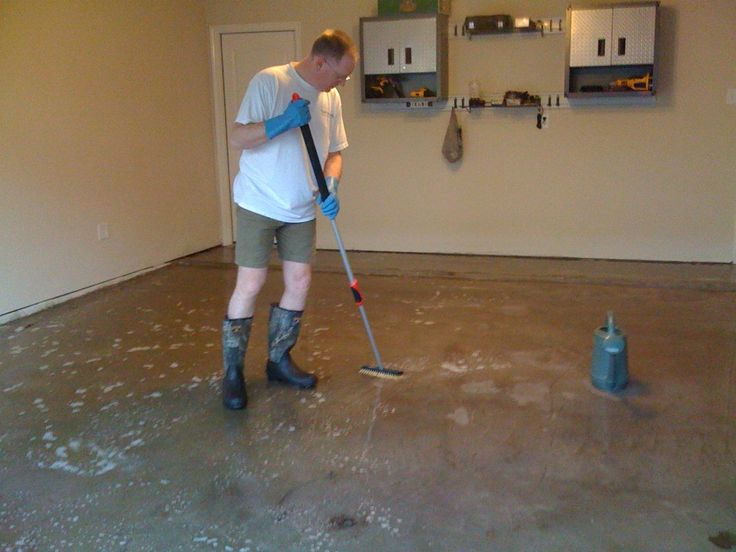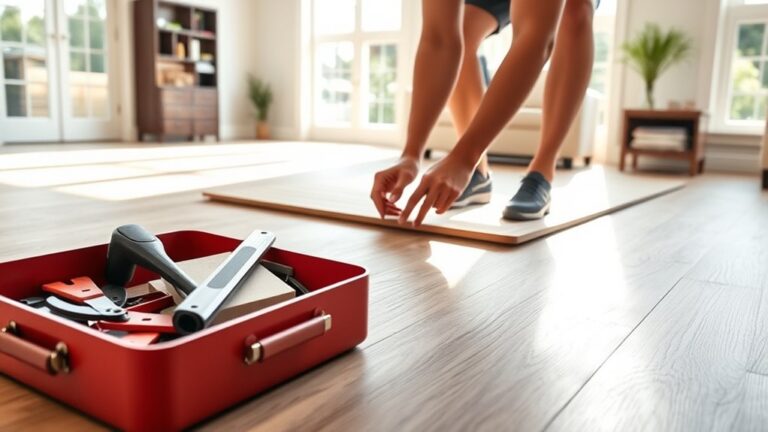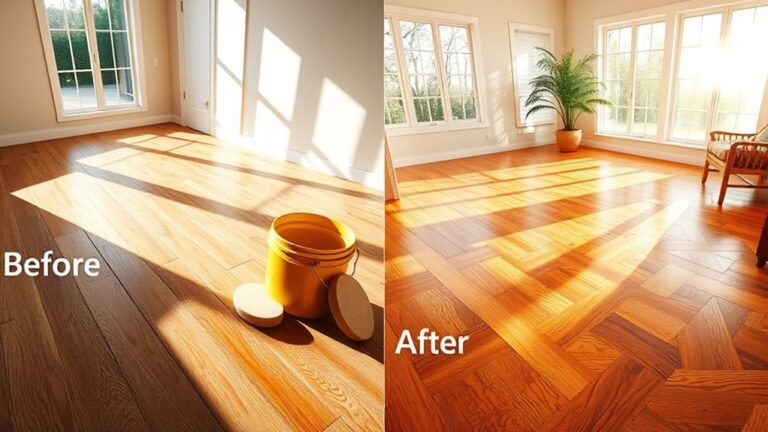To fix a pitted garage floor, first, clean the surface thoroughly. Then, use an epoxy or concrete resurfacer to fill in the pits and level the floor.
Maintaining a smooth and well-maintained garage floor is essential for both the aesthetic appeal and functionality of your space. However, over time, pitting can occur due to factors like heavy use, moisture, or the use of harsh chemicals. These unsightly pits not only diminish the visual appeal of your garage but can also create tripping hazards and damage your vehicle tires.
Luckily, fixing a pitted garage floor can be a relatively straightforward DIY project. We will walk you through the steps to repair and restore your pitted garage floor, ensuring it looks as good as new.
Understanding Pitted Garage Floors
Pitted garage floors are a common issue that can arise due to several reasons. Identifying the causes and recognizing the signs of pitted floors is essential to effectively fix the problem.
| Cause | Description |
|---|---|
| Poor concrete mix | Insufficient or improper mixing of concrete during floor installation can result in pitting over time. |
| Chemical exposure | Strong chemicals such as oil spills or corrosive substances can eat away at the garage floor surface, leading to pits. |
| Freeze-thaw cycles | In regions with fluctuating temperatures, the expansion and contraction of moisture within the concrete can cause pitting. |
- Small holes or depressions on the floor surface
- Chipped or crumbling concrete
- Uneven and rough texture
- Difficulty in cleaning and maintaining the floor
Identifying the causes and understanding the signs of pitted garage floors is the first step towards fixing the issue. With proper knowledge, you can proceed to implement the right solutions and restore the appearance and functionality of your garage floor.
Assessing The Severity Of The Damage
To accurately fix a pitted garage floor, it is crucial to assess the severity of the damage. This will help you determine the appropriate course of action. Here are the steps to determine the extent of the damage:
| Tools | Materials |
|---|---|
|
|
1. Clean the floor thoroughly using a cleaning solution to remove any debris or dirt that may interfere with the assessment process.
2. Put on gloves, safety goggles, and a dust mask for protection.
3. Inspect the floor for visible cracks, pits, or other forms of damage. Use a flashlight to identify any hidden cracks.
4. Measure the depth and width of the pits using a tape measure.
5. Mark the damaged areas with chalk or a marker.
6. Place a straightedge or level across the floor to determine if there are any uneven surfaces.
By following these steps, you will be able to assess the severity of the damage accurately. This assessment will guide you in selecting the most appropriate solution to fix the pitted garage floor efficiently.
Preparing Your Garage For Floor Repair
Clearing out the garage space is the first step in preparing your garage for floor repair. Remove all items, including vehicles, tools, and storage, to create an empty and clutter-free space. This will allow you to easily access the entire garage floor and provide a clean area for the repair work.
Cleaning and prepping the floor surface is the next important step. Start by sweeping away any loose debris, dirt, and dust. Use a high-pressure washer or a cleanser specifically designed for garage floors to remove any stubborn stains, oil spills, or grease. It is crucial to thoroughly clean the entire surface to ensure proper adhesion of the repair materials.
Once the floor is clean, inspect it for any pitted or damaged areas. Use a chisel or a grinder with a diamond-tipped blade to carefully remove any loose or deteriorating concrete. Make sure to wear protective goggles and a dust mask during this process.
| Tools and materials needed for garage floor repair: |
|---|
| Chisel |
| Grinder with diamond-tipped blade |
| Protective goggles |
| Dust mask |
| High-pressure washer or cleanser |
| Concrete repair mix |
| Concrete bonding agent |
| Trowel or squeegee |
After successfully preparing your garage for floor repair, you will be ready to move on to the actual fixing process.

Choosing The Right Repair Method
Title: How to Fix Pitted Garage FloorHeading: Choosing the Right Repair MethodSubheading: Epoxy Floor Coating
When dealing with a pitted garage floor, it is crucial to choose the right repair method that will effectively restore the floor’s appearance and functionality. One popular option is epoxy floor coating. This method involves applying a durable epoxy coating to the floor surface, which not only fills in the pits but also creates a smooth and seamless finish.
Another solution to consider is concrete resurfacing. This involves applying a thin layer of fresh concrete over the pitted area, creating a new surface that hides imperfections. Concrete resurfacing is a cost-effective and efficient way to fix pitted garage floors.
Additionally, polyurethane mortar systems are another repair method worth exploring. These systems involve using a special polyurethane mortar mix to fill in the pits and create a strong and long-lasting surface. However, it’s important to note that this method requires proper knowledge and expertise to ensure a successful repair.
Each of these repair methods offers its own benefits, so it’s important to evaluate your specific needs and consult with a professional to determine the most suitable solution for your pitted garage floor.
Repairing Pitted Garage Floors With Epoxy Coating
To fix a pitted garage floor, the process typically involves repairing the surface with an epoxy coating. Before applying the epoxy, it is crucial to properly prepare the floor. This involves several steps:
1. Clean the Floor: Start by thoroughly cleaning the floor to remove any dirt, oil, or debris. Use a degreaser and scrub brush, followed by rinsing the floor with water.
2. Fill Pits and Cracks: Next, inspect the floor for any pits or cracks. Fill these imperfections with an epoxy crack filler or a concrete patching compound. Smooth out the surface and let it dry completely.
3. Etch the Surface: To ensure good adhesion between the epoxy and the floor, etch the surface using an acid-based concrete etcher or a specialized etching solution. Follow the manufacturer’s instructions and rinse the floor thoroughly after etching.
4. Apply the Epoxy Coating: Once the floor is clean, patched, and etched, it’s time to apply the epoxy coating. Mix the epoxy according to the manufacturer’s instructions and use a roller or a squeegee to apply a thin, even layer. Work in small sections to ensure proper coverage.
5. Cure and Finish the Floor: After applying the epoxy, allow it to cure as per the manufacturer’s recommendations. This usually involves keeping the area well-ventilated and avoiding foot or vehicle traffic for a specified period. Once cured, you can add additional finishes like a clear topcoat for added protection.
By following these steps, you can effectively repair pitted garage floors with an epoxy coating, ultimately improving the appearance and durability of your garage floor.
Resurfacing Pitted Garage Floors With Concrete
Learn how to resurface and fix pitted garage floors with concrete. This article provides step-by-step instructions on how to restore your garage floor’s smooth and even surface.
To fix a pitted garage floor, you need to make necessary preparations. Start by cleaning the floor thoroughly, removing any dirt, grease, or oil. Repair any cracks or holes, ensuring a smooth surface. It’s important to use a concrete bonding agent to promote adhesion between the existing floor and the resurfacer. Once the preparation is complete, it’s time to apply the concrete resurfacer. Mix the product according to the manufacturer’s instructions and pour it onto the floor. Use a long-handled squeegee to spread the resurfacer evenly, ensuring every pitted area is covered. Finish the process by using a broom to create a textured surface for traction. Allow the resurfacer to cure for the recommended time, which can vary depending on the product used. Once cured, your garage floor will be renewed and protected, ready to withstand daily wear and tear.
Fixing Pitted Garage Floors With Polyurethane Mortar Systems
Polyurethane mortar systems are an effective solution for fixing pitted garage floors. With their durability and resistance to impact and chemicals, these systems provide a long-lasting and seamless finish, ensuring a smooth and safe surface for your garage. Say goodbye to unsightly pits and hello to a restored and attractive garage floor.
Fixing a pitted garage floor may seem like a daunting task, but with polyurethane mortar systems, it can be a relatively straightforward process.
Preparing the floor for polyurethane mortar application involves a few key steps. First, thoroughly clean the floor to remove any debris or loose materials. Next, if there are any cracks or uneven areas, fill them with a suitable filler and allow it to dry. Once the surface is clean and smooth, it’s ready for the polyurethane mortar.
When mixing and applying the polyurethane mortar, it’s important to follow the manufacturer’s instructions for the specific product being used. This may involve combining two or more components and mixing them until a smooth consistency is achieved. Apply the mixed mortar evenly over the pitted areas, ensuring complete coverage.
After the polyurethane mortar is applied, smooth and finish the repaired floor. This can be done by using a trowel or squeegee to create a level surface. Smooth out any imperfections and ensure the repaired floor blends seamlessly with the rest of the garage.
Maintaining A Revamped Garage Floor
Regular cleaning and maintenance are essential to keep your garage floor in top shape, especially when it comes to fixing pitted areas. By following a few simple tips, you can ensure that your revamped garage floor remains in great condition for years to come.
Regular Cleaning And Maintenance Tips
- Sweep and mop: Regularly sweep the floor to remove dirt, dust, and debris. Mop the floor with a mild detergent and warm water to keep it clean and free from stains.
- Use a sealant: Apply a sealant to protect the surface and prevent further damage. This will also enhance the appearance of your garage floor.
- Repair cracks promptly: Address any cracks or pitted areas as soon as you notice them. Fill them with an appropriate concrete patching compound to prevent further deterioration.
Preventive Measures To Avoid Future Damage
- Avoid heavy impacts: Take caution when moving heavy objects or using tools in the garage. Place protective mats or pads under items that may cause damage to the floor.
- Keep chemicals away: Avoid spilling chemicals or harsh substances on the floor, as they can cause pitting and discoloration. Clean up any spills immediately.
- Regular inspections: Periodically inspect your garage floor for signs of damage or pitting. Catching any issues early on will help prevent them from worsening.
By following these maintenance and preventive measures, you can effectively fix pitted areas on your garage floor and prolong its lifespan, ensuring a well-maintained and appealing space for your vehicles and other items.
Frequently Asked Questions On How To Fix Pitted Garage Floor
What Is The Best Product For A Pitted Garage Floor?
The best product for a pitted garage floor is a high-quality epoxy floor coating. It provides a durable and smooth surface, filling in the pits and preventing future damage. Epoxy coatings are easy to apply and offer excellent resistance to stains, chemicals, and abrasions, making them an ideal choice for garage floors.
Why Is My Garage Floor Pitting?
Garage floors can pit due to several reasons, including moisture, freeze-thaw cycles, chemical spills, and inadequate surface preparation. High humidity or water leakage can lead to moisture penetrating the concrete, causing it to deteriorate and form pits. Similarly, repeated freeze-thaw cycles can weaken the concrete, resulting in pitting.
Chemical spills can also eat away at the surface, leading to small holes and pits. Lastly, improper surface preparation, such as insufficient cleaning or poor-quality coatings, can cause the floor to pit over time.
Can You Paint A Pitted Garage Floor?
Yes, you can paint a pitted garage floor.
How Do You Repair Divots In Concrete Floor?
Repairing divots in a concrete floor is simple. Start by cleaning the area thoroughly and removing any loose debris. Then, apply a concrete patching compound to fill the divot, ensuring it is smooth and level. Allow the compound to dry before applying a sealant or coating for added protection.
Conclusion
To sum up, fixing a pitted garage floor is a manageable task with the right approach. By assessing the severity of the pits, preparing the surface properly, and using the appropriate materials, you can restore your garage floor to its former glory.
Regular maintenance and preventative measures, such as sealing the concrete and avoiding harsh chemicals, can also help extend the lifespan of your garage floor. With these tips in mind, you’ll be well-equipped to tackle any pitted garage floor issue that comes your way.




